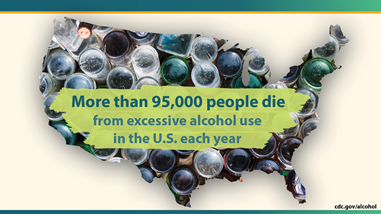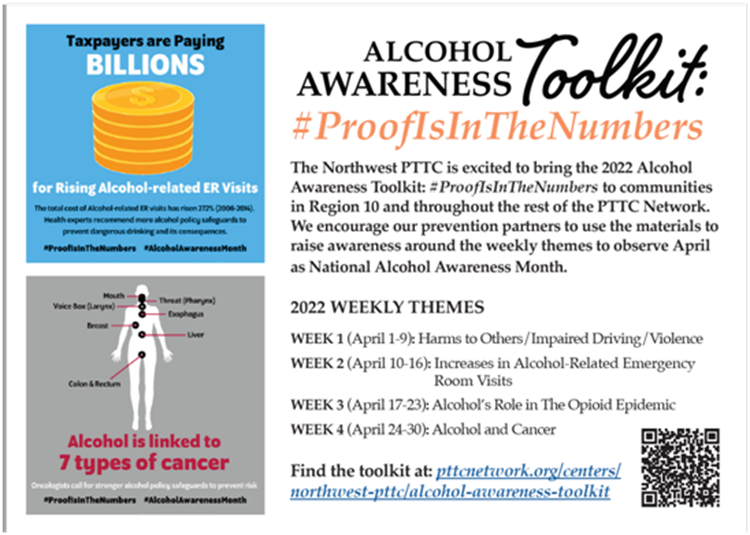Home > Gratitude for Alcohol Awareness Month
By Cele Fichter-DeSando, MPM
As prevention practitioners, it is easy to become desensitized to problems and issues that seem persistent, insurmountable, and never-ending. At times this desensitization is rooted in an inability to know what action to take or the next step needed to address a long-standing problem.
Excessive alcohol use is one such concern that can have us wondering what to do next. What effective strategies should we implement to address the harmful effects associated with alcohol misuse? To address excessive alcohol use, we must know the facts and use the latest research to guide our next steps.
Excessive Alcohol Use
According to the Centers for Disease Control and Prevention (CDC), excessive alcohol use is responsible for more than 95,000 deaths each year in the United States. Harm associated with alcohol use can be exhibited in the deaths attributed to alcohol over a longer period, such as those from heart disease, liver disease, and various cancers. The deaths account for more than half of the alcohol-related deaths. In addition, more immediate effects related to excessive alcohol use are seen in potential life years lost due to deaths by suicide, vehicle crashes, and poisonings involving substances in addition to alcohol.

The CDC describes excessive alcohol use as
No Safe Level of Alcohol Consumption
The World Heart Foundation (WHF) is urging countries and organizations to come together to convey uniform, evidence-based messages, and policy agendas regarding alcohol use.The World Heart Foundation (WHF) issued a 2022 policy brief, in a global effort to addressa a. According to the 2022 policy brief, THE IMPACT OF ALCOHOL CONSUMPTION ON CARDIOVASCULAR HEALTH: MYTHS AND MEASURES, more than 2.4 million deaths worldwide were attributed in 2019 to alcohol use including deaths due to infectious diseases, intentional and unintentional injuries, digestive diseases, and several other non-communicable diseases, including cancer. The policy brief outlines research to counter the claims that alcohol provides health benefits and protection from cardiovascular disease and emphasizes the message that no level of alcohol consumption is safe for health and that any level of alcohol consumption can lead to loss of healthy life.
WHF stresses that global policy agendas should address the unequal burden related to harm from alcohol use. Alcohol harm paradox research is outlined describing that individuals with low socioeconomic status experience a disproportionately greater alcohol-associated harm than individuals with high socioeconomic status. Policy agenda measures are needed that address inequality that can be attributed to overall health status, access to health services, the safety of the environment where alcohol is consumed, and patterns of alcohol use.
|
April Alcohol Awareness Gratitude List |
|
1. I am grateful that April is Alcohol Awareness Month. |
|
2. I am grateful that since the 1980s there is a time each year to make alcohol awareness a priority. |
|
3. I am grateful that there are new partnerships and organizations such as the Center for Advancing Alcohol Science to Practice dedicated to helping communities to build their capacity for health, safety, and evidence-based population-level strategies to address excessive alcohol use. |
|
4. I am grateful for the toolkits and resources listed in this newsletter that are available for use for alcohol awareness campaigns. |
|
5. I am grateful for evidence-based strategies to reduce harm and prevent excessive alcohol use. |
Gratitude and Alcohol Awareness Month
As we concentrate our efforts to address excessive alcohol use, the inequities associated with alcohol harm, and the best strategies for the communities in which we work, what steps should we take?
I humbly suggest that the first step we take as we begin alcohol awareness month is a step of gratitude grounded in a strategic focus.
Robert A. Emmons, professor of psychology at the University of California, Davis (UC Davis) and researcher on the science of gratitude has found that “gratitude reduces lifetime risk for depression, anxiety, and substance abuse disorders, and is a key resiliency factor in the prevention of suicide.” Emmons believes that practicing gratitude affects our behaviors and contributes to healthier more positive lives.
In the UC Davis feature post Gratitude is Good Medicine, gratitude is described as having two components. The first part of gratitude is the acknowledgment that there are good things or goodness in the world and that while not perfect, there are benefits that exist. The second part of gratitude is exploring where the good things or goodness come from and acknowledging that there are good things outside of oneself. This acknowledgment that there are good things external to the self, helps us to establish interconnectedness and interdependence that we can use to achieve goals and solve problems. Emmons and other experts suggest starting a practice of gratitude by keeping a gratitude journal or notebook or making a list of things we are grateful for and their origins. A gratitude list can get us started on an action plan for addressing excessive alcohol use.
The Center for Advancing Alcohol Science to Practice
As Dr. Emmons suggests connectedness and behavior change are linked not just to expressing gratitude but also to exploring the origin of that for which I am grateful. On the subject of gratitude, author, motivational trainer, and certified breathwork coach Alexandra Elle writes “I am thankful for my struggle because without it I wouldn’t have stumbled upon my strength.” As we struggle with inequity, persistent concerns, and seemingly insurmountable problems there are many strengths that we can draw upon.
One source of my gratitude this year is the newly formed Center for Advancing Alcohol Science to Practice (the center). Funded by the Centers for Disease Control and Prevention’s Alcohol Program, the center is committed to preventing excessive alcohol use by using alcohol science for the community good.

The center aims to create more knowledgeable and connected communities across the nation through
Bringing together existing organizations and resources, the center has formed a Partnership Council, of which the PTTC is a member. With a vision of bringing tangible resources and expanded voices to the work of communities, the Partnership Council serves as a critical component in coordinating the provision of those resources to coalition partners across the country.
Keeping a focus on making the evidence real for community partners, the center uses the framework of approaches outlined in The Guide to Community Preventive Services (The Community Guide) to direct the development of population-level, evidence-based strategies. Effective interventions listed in the Community Guide include Dram Shop Liability, Electronic Screening and Brief Intervention (e-SBI), Increasing Alcohol Taxes, and Maintaining Limits on Days of Sale. While these interventions can be daunting if viewed as a first step, they are commonly embedded within a larger plan that supports the desired outcome such as increasing alcohol taxes or implementing electronic screening. The center works with community and state partners to form a plan and implement and advance the strategies necessary to achieve the desired outcome. Sara Cooley Broschart, the director of the center explains how they can help. “We will offer community and state partners technical assistance to move towards the policy solutions that we know make lasting change around alcohol, such as those found in The Community Guide. We can walk coalition and community partners through a process of understanding their local conditions and opportunities as they relate to what we know works from the evidence. We’re here to help! You can learn more and access resources at our new website: alcoholsciencetopractice.org or email us at [email protected] to find out more and how we can help you get there,” said Cooley Broshcart.
Gratitude to Action - The Next Steps
If the first step for Alcohol Awareness Month is gratitude and an exploration of the source of that gratitude, what are the next steps? How do we prioritize reducing excessive alcohol use and preventing alcohol-related harm? The next steps for addressing excessive alcohol use in your community involve utilizing the science, resources, and organizations dedicated to addressing the harm associated with alcohol use.

Conclusion
Health professionals, prevention practitioners, educators, and policymakers all have a role to play in preventing excessive alcohol use and alcohol-related harm. Thankfully, there is a great deal of research and science to guide policies, strategies, messages, and programs that can be effectively used by communities and states. We can turn our gratitude into action. Connect with the Center for Advancing Alcohol Science to Practice, SAMHSA, Alcohol and Public Health | CDC, HaRRT Center – Harm Reduction Research & Treatment Center, and Prevention Technology Transfer Center (PTTC) Network and use the resources available to implement evidence-based strategies for preventing alcohol misuse and excessive alcohol use while creating healthy, safe, and equitable neighborhoods. As the center puts it “alcohol science for the community good.”
Author's Note
Cele Fichter-DeSando, MPM (She, Her, Hers)
7069 Highland Creek Drive
Bridgeville PA, 15017
412-580-3089
[email protected]
References
Center for Advancing Alcohol Science to Practice (the center). 2022 https://alcoholsciencetopractice.org/about-the-center/ Retrieved: March 18, 2022.
Centers for Disease Control and Prevention (CDC). Alcohol and Public Health. Deaths from Excessive Alcohol Use in the United States
https://www.cdc.gov/alcohol/features/excessive-alcohol-deaths.html Page last reviewed January 14, 2021. Retrieved March 13, 2022.
Elle Alexandra. 2018. Alex Elle Gratitude Weekly. https://alexellewrites.bulletin.com/
Guide to Community Preventive Services. Excessive Alcohol Consumption. https://www.thecommunityguide.org/topic/excessive-alcohol-consumption. Review Completed August 2012. Retrieved: March 14, 2022.
Kilina Carolin, Lange Shannon, Probst Charlotte, et al., The Role of Alcohol Use and Drinking Patterns in Socioeconomic Inequalities in Mortality: A Systematic Review. The Lancet Public Health. June 2020. DOI:https://doi.org/10.1016/S2468-2667(20)30052-9.|
Nodell B. UW Newsroom 2021. Harm-Reduction Experts Offer Tips on Safe Drinking. Featured Post. March 23. 2021. https://newsroom.uw.edu/postscript/harm-reduction-experts-offer-tips-safe-drinking
Retrieved: March 13, 2022.
UC Davis Health, Medical Center 2015. Feature Post “Gratitude is Good Medicine” November 25, 2015. Retrieved: March 13, 2022.
https://health.ucdavis.edu/medicalcenter/features/2015-2016/11/20151125_gratitude.html
World Heart Federation (WHF) 2022. The Impact of Alcohol Consumption on Cardiovascular Health: Myths and Measures January 2022. https://world-heart-federation.org/wp-content/uploads/WHF-Policy-Brief-Alcohol.pdf